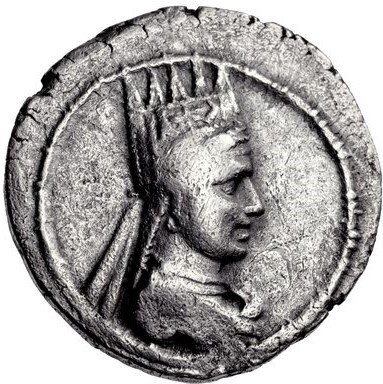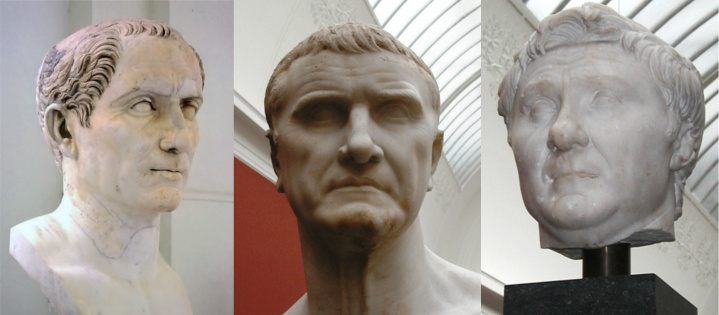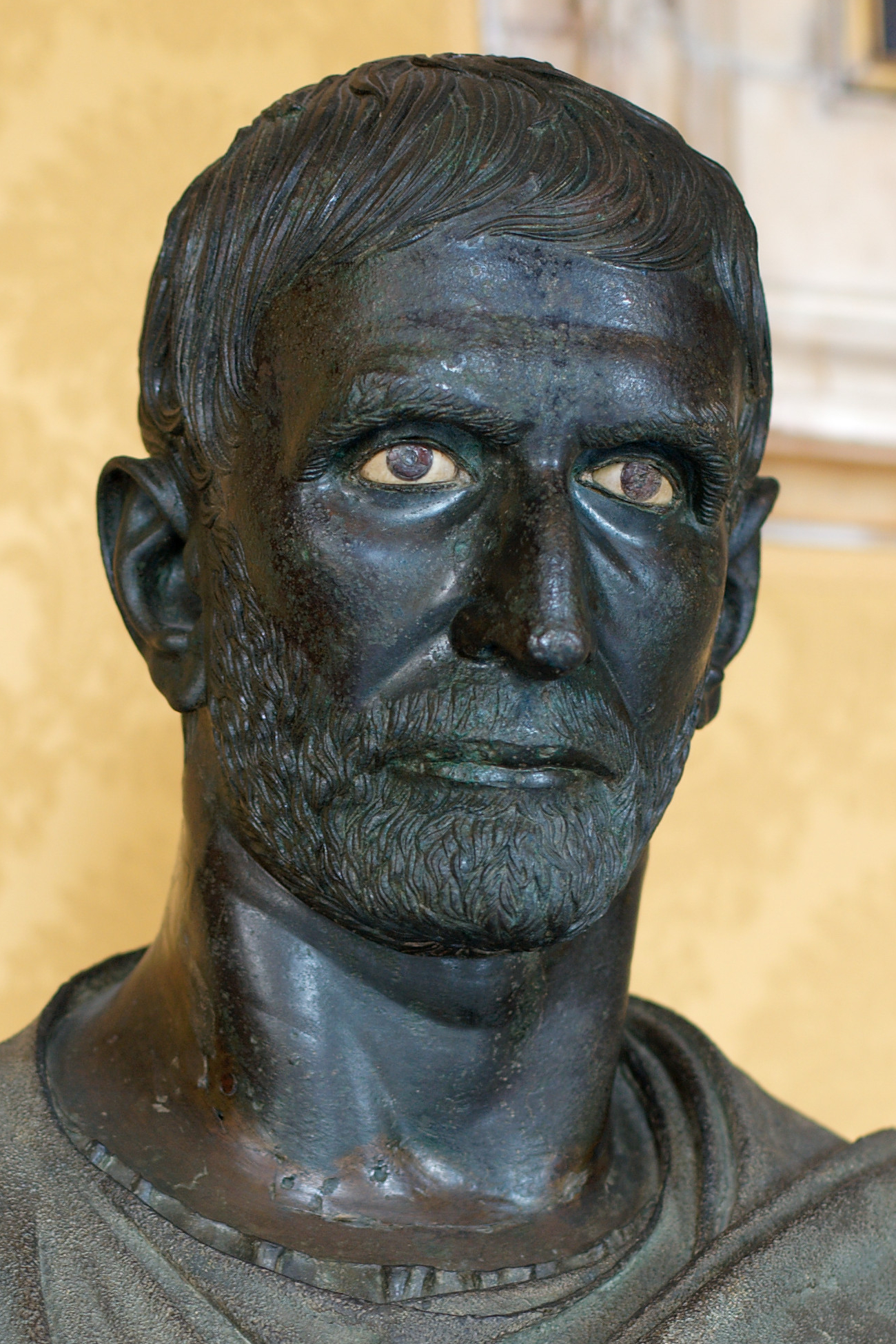|
Artavasdes II Of Armenia
Artavasdes II ( grc, ΑΡΤΑΒΑΖΔΟΥ ''Artabázēs'') was king of Armenia from 55 BC to 34 BC. A member of the Artaxiad Dynasty, he was the son and successor of Tigranes the Great (). His mother was Cleopatra of Pontus, thus making his maternal grandfather the prominent Pontus king Mithridates VI Eupator. Like his father, Artavasdes continued using the title of King of Kings, as seen from his coins. Name Artavasdes' name is the Latin attestation of an Old Iranian name ''*Ṛtavazdah-'', identical to the Avestan ''Ašavazdah'', presumably meaning "powerful/persevering through truth". It is attested in Armenian as ''Artavazd'' and in Greek as ''Artaouásdēs'', ''Artabázēs'', ''Artábazos'', and ''Artáozos''. Biography In , Marcus Licinius Crassus, one of the Roman triumvirs, who had become proconsul of Syria, had been preparing to invade the Parthian realm. Artavasdes II, who was an ally of Rome, advised Crassus to take a route through Armenia to avoid the desert ... [...More Info...] [...Related Items...] OR: [Wikipedia] [Google] [Baidu] |
King Of Kings
King of Kings; grc-gre, Βασιλεὺς Βασιλέων, Basileùs Basiléōn; hy, արքայից արքա, ark'ayits ark'a; sa, महाराजाधिराज, Mahārājadhirāja; ka, მეფეთ მეფე, ''Mepet mepe''; gez, ንጉሠ ነገሥት, Nəgusä Nägäst, group="n" was a ruling title employed primarily by monarchs based in the Middle East. Though most commonly associated with Iran (historically known as Persia in the West), especially the Achaemenid and Sasanian Empires, the title was originally introduced during the Middle Assyrian Empire by king Tukulti-Ninurta I (reigned 1233–1197 BC) and was subsequently used in a number of different kingdoms and empires, including the aforementioned Persia, various Hellenic kingdoms, Armenia, Georgia, and Ethiopia. The title is commonly seen as equivalent to that of Emperor, both titles outranking that of king in prestige, stemming from the medieval Byzantine emperors who saw the '' Shahanshahs' ... [...More Info...] [...Related Items...] OR: [Wikipedia] [Google] [Baidu] |
Avestan
Avestan (), or historically Zend, is an umbrella term for two Old Iranian languages: Old Avestan (spoken in the 2nd millennium BCE) and Younger Avestan (spoken in the 1st millennium BCE). They are known only from their conjoined use as the scriptural language of Zoroastrianism, and the Avesta likewise serves as their namesake. Both are early Eastern Iranian languages within the Indo-Iranian language branch of the Indo-European language family. Its immediate ancestor was the Proto-Iranian language, a sister language to the Proto-Indo-Aryan language, with both having developed from the earlier Proto-Indo-Iranian language; as such, Old Avestan is quite close in both grammar and lexicon to Vedic Sanskrit, the oldest preserved Indo-Aryan language. The Avestan text corpus was composed in the ancient Iranian satrapies of Arachosia, Aria, Bactria, and Margiana, corresponding to the entirety of present-day Afghanistan as well as parts of Tajikistan, Turkmenistan, and Uzbek ... [...More Info...] [...Related Items...] OR: [Wikipedia] [Google] [Baidu] |
Pacorus I
Pacorus I (also spelled Pakoros I; xpr, 𐭐𐭊𐭅𐭓; died 38 BC) was a Parthian prince, who was the son and heir of Orodes II (). The numismatist David Sellwood deduced that Pacorus ruled in . It is uncertain whether Pacorus ruled alongside his father, or ruled independently. His wife was an unnamed Armenian princess, who was a sister of the Artaxiad king of Armenia, Artavasdes II (). Following the Parthian victory against the Romans at the Battle of Carrhae in 53 BC, the Parthians attempted to capture Roman-held territories in Western Asia, with Pacorus acting as one of the leading commanders. Although they were initially successful, they were repelled by the Romans. Pacorus himself was defeated and killed at the Battle of Mount Gindarus by the forces of the Publius Ventidius Bassus. His death spurred a succession crisis in which Orodes II, deeply afflicted by the death of his favourite son, relinquished the throne to his other son Phraates IV () as his new heir. Name ... [...More Info...] [...Related Items...] OR: [Wikipedia] [Google] [Baidu] |
Orodes II
Orodes II (also spelled Urud II; xpr, 𐭅𐭓𐭅𐭃 ''Wērōd''), was King of Kings of the Parthian Empire from 57 BC to 37 BC. He was a son of Phraates III, whom he murdered in 57 BC, assisted by his elder brother Mithridates IV. The two brothers quickly fell out and entered into a dynastic struggle, in which Orodes was triumphant. Meanwhile, the Roman general and triumvir Marcus Licinius Crassus had made an attempt to extend his share of Roman territory by eastward conquest. This attempt proved disastrous, with Crassus meeting his end in 53 BC, in the Battle of Carrhae, by Orodes' general Surena. Orodes himself had invaded Armenia and forced king Artavasdes II () to submit and abandon his alliance with the Romans. The victory at Carrhae secured for the Parthians the countries east of the Euphrates. Then, the next year they invaded Syria, but with little success. Surena, whose achievements had made him too dangerous, was killed by Orodes, and Pacorus I, the son and hei ... [...More Info...] [...Related Items...] OR: [Wikipedia] [Google] [Baidu] |
Turkey
Turkey ( tr, Türkiye ), officially the Republic of Türkiye ( tr, Türkiye Cumhuriyeti, links=no ), is a list of transcontinental countries, transcontinental country located mainly on the Anatolia, Anatolian Peninsula in Western Asia, with a East Thrace, small portion on the Balkans, Balkan Peninsula in Southeast Europe. It shares borders with the Black Sea to the north; Georgia (country), Georgia to the northeast; Armenia, Azerbaijan, and Iran to the east; Iraq to the southeast; Syria and the Mediterranean Sea to the south; the Aegean Sea to the west; and Greece and Bulgaria to the northwest. Cyprus is located off the south coast. Turkish people, Turks form the vast majority of the nation's population and Kurds are the largest minority. Ankara is Turkey's capital, while Istanbul is its list of largest cities and towns in Turkey, largest city and financial centre. One of the world's earliest permanently Settler, settled regions, present-day Turkey was home to important Neol ... [...More Info...] [...Related Items...] OR: [Wikipedia] [Google] [Baidu] |
Harran
Harran (), historically known as Carrhae ( el, Kάρραι, Kárrhai), is a rural town and district of the Şanlıurfa Province in southeastern Turkey, approximately 40 kilometres (25 miles) southeast of Urfa and 20 kilometers from the border crossing with Syria at Akçakale. Harran was founded at some point between the 25th and 20th centuries BC as a merchant colony by Sumer, Sumerian traders from Ur. Over the course of its early history, Harran rapidly grew into a major Mesopotamia, Mesopotamian cultural, commercial and religious center. It was made a religiously and politically influential city through its association with the moon-god Sin (mythology), Sin; many prominent Mesopotamian rulers consulted with and renovated the moon-temple of Ekhulkhul in Harran. Harran came under Assyria, Assyrian rule under Adad-nirari I ( BC) and became a provincial capital often second in importance only to the Assyrian capital of Assur itself. During the collapse of the Assyrian Empire, Harra ... [...More Info...] [...Related Items...] OR: [Wikipedia] [Google] [Baidu] |
Battle Of Carrhae
The Battle of Carrhae () was fought in 53 BC between the Roman Republic and the Parthian Empire near the ancient town of Carrhae (present-day Harran, Turkey). An invading force of seven legions of Roman heavy infantry under Marcus Licinius Crassus was lured into the desert and decisively defeated by a mixed cavalry army of heavy cataphracts and light horse archers led by the Parthian general Surena. On such flat terrain, the Legion proved to have no viable tactics against the highly-mobile Parthian horsemen, and the slow and vulnerable Roman formations were surrounded, exhausted by constant attacks, and eventually crushed. Crassus was killed along with the majority of his army. It is commonly seen as one of the earliest and most important battles between the Roman and Parthian Empires and one of the most crushing defeats in Roman history. According to the poet Ovid in Book 6 of his poem ''Fasti'', the battle occurred on the 9th day of June. Crassus, a member of the First ... [...More Info...] [...Related Items...] OR: [Wikipedia] [Google] [Baidu] |
The Portrait Of Artavasdes II Of Armenia On The Obverse Of A Drachm, Artaxata Mint
''The'' () is a grammatical article in English, denoting persons or things that are already or about to be mentioned, under discussion, implied or otherwise presumed familiar to listeners, readers, or speakers. It is the definite article in English. ''The'' is the most frequently used word in the English language; studies and analyses of texts have found it to account for seven percent of all printed English-language words. It is derived from gendered articles in Old English which combined in Middle English and now has a single form used with nouns of any gender. The word can be used with both singular and plural nouns, and with a noun that starts with any letter. This is different from many other languages, which have different forms of the definite article for different genders or numbers. Pronunciation In most dialects, "the" is pronounced as (with the voiced dental fricative followed by a schwa) when followed by a consonant sound, and as (homophone of the archaic pr ... [...More Info...] [...Related Items...] OR: [Wikipedia] [Google] [Baidu] |
Mesopotamia
Mesopotamia ''Mesopotamíā''; ar, بِلَاد ٱلرَّافِدَيْن or ; syc, ܐܪܡ ܢܗܪ̈ܝܢ, or , ) is a historical region of Western Asia situated within the Tigris–Euphrates river system, in the northern part of the Fertile Crescent. Today, Mesopotamia occupies modern Iraq. In the broader sense, the historical region included present-day Iraq and Kuwait and parts of present-day Iran, Syria and Turkey. The Sumerians and Akkadians (including Assyrian people, Assyrians and Babylonians) originating from different areas in present-day Iraq, dominated Mesopotamia from the beginning of recorded history, written history () to the fall of Babylon in 539 BC, when it was conquered by the Achaemenid Empire. It fell to Alexander the Great in 332 BC, and after his death, it became part of the Greek Seleucid Empire. Later the Arameans dominated major parts of Mesopotamia (). Mesopotamia is the site of the earliest developments of the Neolithic Revolution from aroun ... [...More Info...] [...Related Items...] OR: [Wikipedia] [Google] [Baidu] |
Roman Syria
Roman Syria was an early Roman province annexed to the Roman Republic in 64 BC by Pompey in the Third Mithridatic War following the defeat of Kingdom of Armenia (antiquity), King of Armenia Tigranes the Great. Following the partition of the Herodian Kingdom of Judea into Tetrarchy, tetrarchies in 6 AD, it was gradually absorbed into Roman provinces, with Roman Syria annexing Iturea and Trachonitis (tetrarchy), Iturea and Trachonitis. Provincia Syria Syria was annexed to the Roman Republic in 64 BC, when Pompey, Pompey the Great had the Seleucid Empire, Seleucid king Antiochus XIII Asiaticus executed and deposed his successor Philip II Philoromaeus. Pompey appointed Marcus Aemilius Scaurus (praetor 56 BC), Marcus Aemilius Scaurus to the post of Proconsul of Syria. Following the fall of the Roman Republic and its transformation into the Roman Empire, Syria became a Roman imperial province, governed by a Legatus, Legate. During the early empire, the Roman army in Syria accounte ... [...More Info...] [...Related Items...] OR: [Wikipedia] [Google] [Baidu] |
First Triumvirate
The First Triumvirate was an informal political alliance among three prominent politicians in the late Roman Republic: Gaius Julius Caesar, Gnaeus Pompeius Magnus and Marcus Licinius Crassus. The constitution of the Roman republic had many veto points. In order to bypass constitutional obstacles and force through the political goals of the three men, they forged in secret an alliance where they promised to use their respective influence to support each other. The "triumvirate" was not a formal magistracy, nor did it achieve a lasting domination over state affairs. It was formed between the three men due to their mutual need to overcome opposition in the senate against their proposals in the previous years. Initially secret, it emerged publicly during Caesar's first consulship in 59 BC to push through legislation for the three allies. Caesar secured passage of an agrarian law which helped resettle Pompey's veterans, a law ratifying Pompey's settlements after the Third Mi ... [...More Info...] [...Related Items...] OR: [Wikipedia] [Google] [Baidu] |
Roman Republic
The Roman Republic ( la, Res publica Romana ) was a form of government of Rome and the era of the classical Roman civilization when it was run through public representation of the Roman people. Beginning with the overthrow of the Roman Kingdom (traditionally dated to 509 BC) and ending in 27 BC with the establishment of the Roman Empire, Rome's control rapidly expanded during this period—from the city's immediate surroundings to hegemony over the entire Mediterranean world. Roman society under the Republic was primarily a cultural mix of Latin and Etruscan societies, as well as of Sabine, Oscan, and Greek cultural elements, which is especially visible in the Roman Pantheon. Its political organization developed, at around the same time as direct democracy in Ancient Greece, with collective and annual magistracies, overseen by a senate. The top magistrates were the two consuls, who had an extensive range of executive, legislative, judicial, military, and religious powe ... [...More Info...] [...Related Items...] OR: [Wikipedia] [Google] [Baidu] |



.png)


